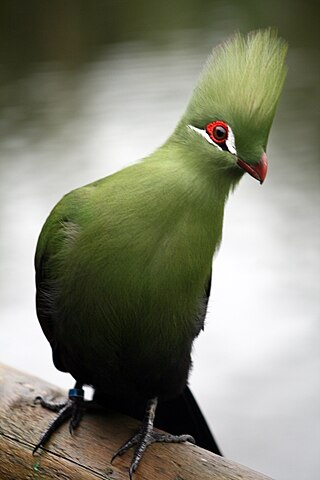
The turacos make up the bird family Musophagidae ( "banana-eaters"), which includes plantain-eaters and go-away-birds. In southern Africa both turacos and go-away-birds are commonly known as loeries. They are semi-zygodactylous: the fourth (outer) toe can be switched back and forth. The second and third toes, which always point forward, are conjoined in some species. Musophagids often have prominent crests and long tails; the turacos are noted for peculiar and unique pigments giving them their bright green and red feathers.

The western plantain-eater, also known as the grey plantain-eater or western grey plantain-eater, is a large member of the turaco family, a group of large arboreal near-passerine birds restricted to Africa.

The eastern plantain-eater also known as the eastern grey plantain-eater, is a large member of the turaco family, a group of large arboreal near-passerine birds restricted to Africa.

The white-bellied go-away-bird is a bird of eastern Africa in the family Musophagidae, commonly known as turacos.

The great blue turaco is a bird species of the family Musophagidae. At 70–76 cm (28–30 in) in length, it is the largest species of turaco. It has predominantly grey-blue plumage with an upright blue-black crest around 10 cm (3.9 in) high. The male and female have similar plumage. It is widespread throughout the African tropical rainforest.

Hydraenidae is a family of very small aquatic beetles, sometimes called "Minute moss beetles", with a worldwide distribution. They are around 0.8 to 3.3 mm in length. The adults store air on the underside of the body as well as beneath the elytra which allows them to crawl underwater, often on the underside of the water surface tension, though they cannot swim. Some species have gills that effectively allow them to stay underwater indefinitely. Larvae vary from being fully terrestrial, to being aquatic at least in their earliest instars. The diet of hydraenid larvae and adults is thought to consist of algae, spores and other plant matter. At least some hydraenid adults use stridulation to communicate. There are around 1,300 species in 42 genera.

The grey go-away-bird, also known as grey lourie, grey loerie, or kwêvoël, is a bold and common turaco of the southern Afrotropics. They are present in arid to moist, open woodlands and thorn savanna, especially near surface water. They regularly form groups and parties that forage in tree tops, or dust bathe on the ground. Especially when disturbed, they make their presence known by their characteristically loud and nasal "kweh" or "go-way" calls, with the last syllable typically a descending drawl. Within their range, their unique combination of colour, appearance and habits precludes confusion with other bird species.

The bare-faced go-away-bird is a species of bird in the family Musophagidae which is native to the eastern Afrotropics. It is named for its distinctive and uniquely bare, black face.
Erwin Piscator was a German theatre director and producer.

Crinifer is a genus of birds in the turaco family. They are restricted to Africa. Formerly, the genus only contained the plantain-eaters, but in 2021, go-away-birds were merged into the genus.
Abacetus crinifer is a species of ground beetle in the subfamily Pterostichinae. It was described by Tschitscherine in 1899.
Dyschirius crinifer is a species of ground beetle in the subfamily Scaritinae. It was described by Balkenohl in 1993.
Limnebius alutaceus is a species of minute moss beetle in the family Hydraenidae. It is found in North America.
Cylindrarctus crinifer is a species of ant-loving beetle in the family Staphylinidae. It is found in North America.
Cylindrarctus is a genus of ant-loving beetles in the family Staphylinidae. There are about 10 described species in Cylindrarctus.

Omophlus is a genus of comb-clawed beetles belonging to the family Tenebrionidae subfamily Alleculinae.

Limnebius nitidus is a species of beetle belonging to the family Hydraenidae.
Limnebius aluta is a species of beetle belonging to the family Hydraenidae.










